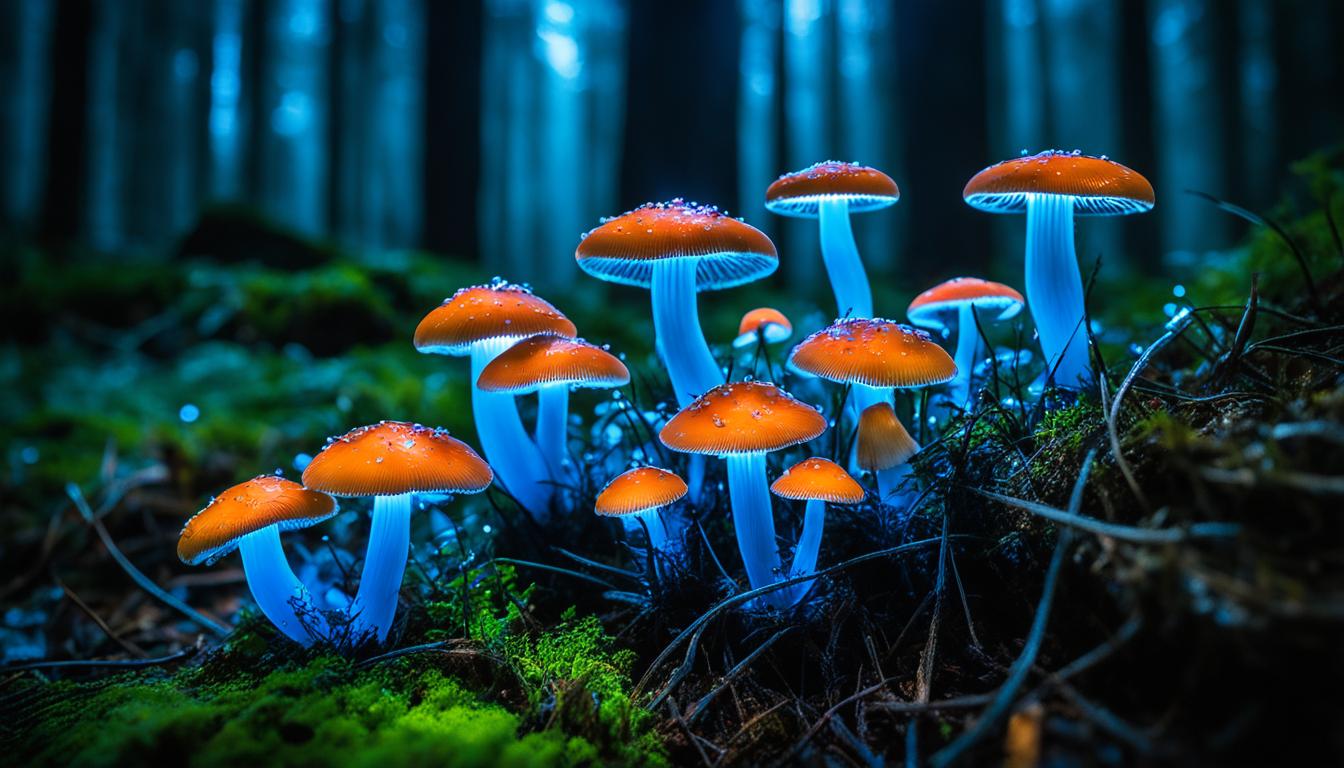Did you know that around 75% of ocean animals use bioluminescence? While luminous ocean creatures get a lot of attention, glowing fungi remain less famous. Yet, these fascinating living lights brighten the forest at night with their beauty. In this piece, we’ll dive into the science of fungi that glow, highlight famous types, and guide you on finding them during your outdoor trips.
Key Takeaways
- Approximately 120 known bioluminescent mushrooms share a common family of luciferins and luciferases.
- The Bitter Oyster is recognized as the brightest bioluminescent mushroom.
- Many bioluminescent fungi species glow continuously under favorable conditions.
- Some fungi time their light production using a circadian clock for optimized visibility at night.
- Research indicates that glowing mushrooms may attract nocturnal arthropods for spore dispersal.
- Scandinavian tribes used bioluminescent fungi as navigational markers through dense forests.
What Are Bioluminescent Fungi?
Bioluminescent fungi are fungal species that shine by producing light through chemical reactions. These special bioluminescence organisms are not just limited to a few types. While fireflies and sea creatures get most of the attention, fungi show us a different, amazing natural light. Imagine walking in a dark forest and seeing these light-emitting fungi glowing. It’s like something out of a fairy tale.
Around the world, we know of more than 113 bioluminescent fungi types. They mainly come from four groups: Omphalotus, Armillaria, Mycenoid, and Lucentipes. Out of these, Armillaria mellea is the most common. It is found in places like Asia, Europe, North America, and South Africa. The discovery of Eoscyphella luciurceolata shows us how much we still have to learn about fungi and their bioluminescence.
The magic of these mushrooms isn’t just in their beauty. It’s also in how they glow. Bioluminescent fungi shine with a specific light range. They can glow in different ways, showing off the unique survival tactics of these light-emitting fungi.
The science behind their glow involves a two-step process with luciferin and luciferase. Factors like pH and temperature affect their glow, causing differences between species. This glowing feature might be an old trait for mushrooms. Scientists think the glow might help spread spores or keep away animals that might eat them.
Understanding the Science of Bioluminescence
The science of bioluminescence shows how some organisms, especially fungi, produce beautiful light. It involves chemical reactions where certain compounds and enzymes create light. Fungi use this glow mainly to break down and decompose material.
How Light is Produced
Bioluminescence comes from a mix of luciferin and the enzyme luciferase. In this chemical reaction, luciferase makes luciferin oxidize, which makes light. Surprisingly, 80% of this light is “cold light,” which doesn’t produce much heat. This trait is helpful for these organisms in their natural roles.
The Role of Luciferins and Luciferases
Luciferins are the compounds that emit light, and luciferases help them do it. In fungi, different kinds of luciferins and luciferases make different light. For example, Neonothopanus gardneri can glow all the time. Recent findings suggest these light-making paths have unique roles, like helping to spread spores or attract insects.
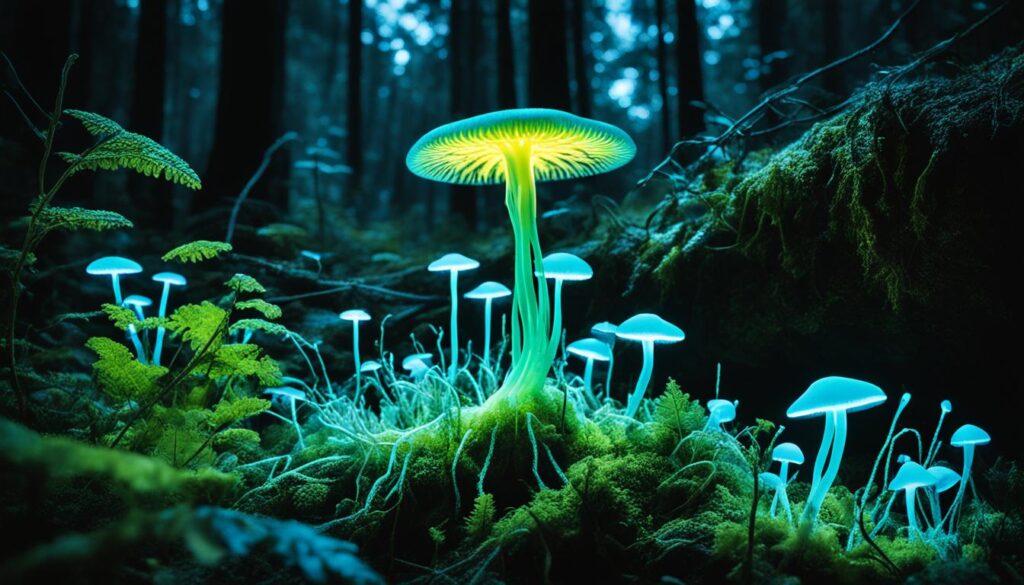
The Fascinating World of Fungal Bioluminescence
Discover the magical world where fungi glow in the dark. This glow draws both people and night creatures. Brightly shining fungi help spread spores by attracting insects like beetles.
This interaction boosts biodiversity. It ties fungi, pollinators, and other animals together in the forest.
The ghost fungus is famous for its eerie green light. It is especially spellbinding in Australian woods. People around the world see glowing mushrooms differently.
In Japan, they’re seen as spirits leading the way. Central and South American natives think they help the dead guide the living at night.
These glowing fungi are more than just a pretty sight. Researchers see them as keys to new technology. They’re exploring how these fungi glow to make green energy and help in medicine.
Enjoy their beauty but don’t touch. Some are poisonous. Their mystery excites both scientists and nature lovers today.
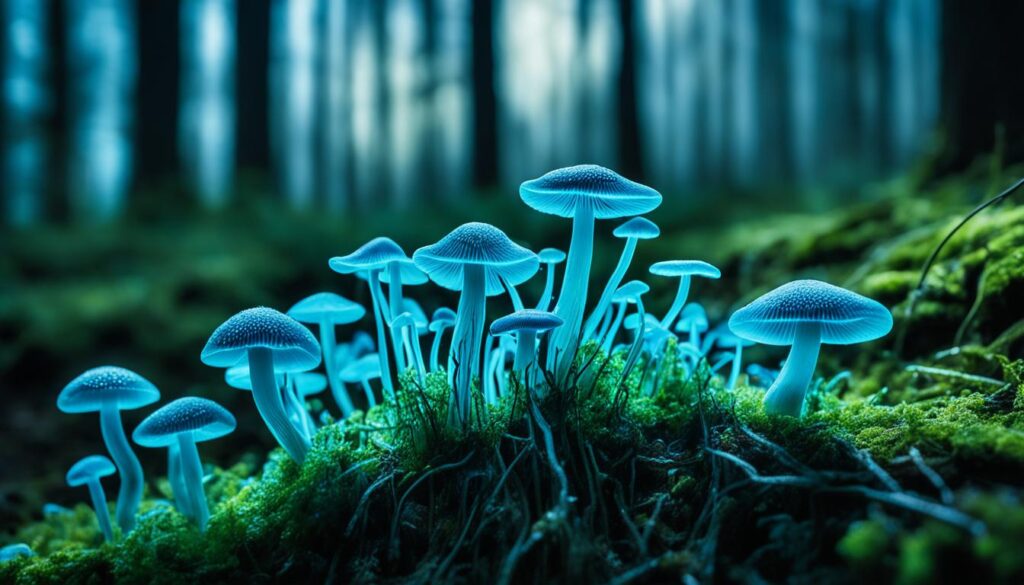
Notable Species of Bioluminescent Fungi
We dive into the incredible world of glowing fungi and find many amazing types. The Jack O’Lantern mushroom and the Bitter Oyster mushroom stand out. Each one reflects unique traits and roles within their habitats.
Jack O’Lantern (Omphalotus illudens)
The Jack O’Lantern mushroom is well-known in North America. It shines bright orange at night. Its green glow, mostly from the gills, makes a captivating view after dark.
However, it’s toxic and should not be eaten. The beauty of this mushroom can be deceiving. So, learn about wild mushrooms before picking any.
Bitter Oyster (Panellus stipticus)
The Bitter Oyster mushroom glows with a soft green light. Like the Jack O’Lantern, its light mainly comes from its gills. It grows on old wood and helps break it down.
While it’s not poisonous, its strong bitter taste makes it unappealing to eat. This mushroom shows how vital fungi are in forests. They play a big part in the environment.
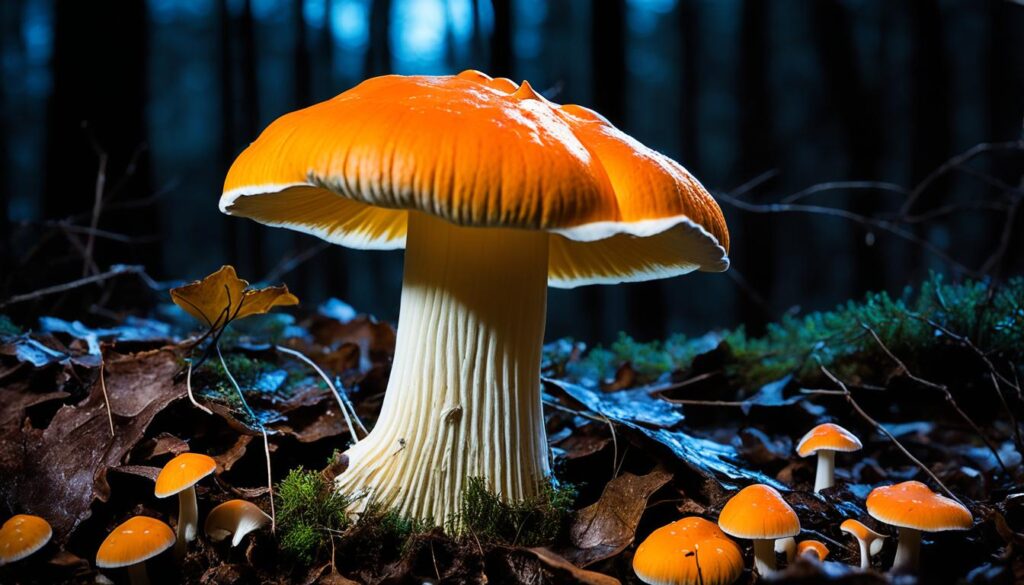
Where to Find Glowing Fungi in the Wild
Looking for bioluminescent fungi in their natural setting is amazing. The Atlantic Forest in Brazil is perfect for seeing glowing mushrooms light up the night. It’s a magical experience.
Nighttime Expeditions in the Atlantic Forest
The Atlantic Forest was once vast, covering 330 million acres. Now, it’s much smaller due to deforestation. But, the Ribeira Valley still has the world’s most glowing mushrooms. This spot offers tours to see these amazing fungi up close.
Over 27 types of glowing mushrooms are found here. The Legado das Águas reserve is the biggest of its kind in Brazil. It’s perfect for exploring these mushrooms. Experts guide the tours, showing off the region’s stunning plants and wildlife.
Experiences in the Amazon Rainforest
The Amazon Rainforest has recently shown off its glowing mushrooms. A possible new kind, the Luminiscens amazonicus, glows a beautiful bluish-green. Joining a trip here, with experts, you can discover new fungi. It’s an adventure you won’t forget.
These trips do more than just show luminous fungi. They highlight how important it is to look after these environments. By visiting, you can see the glow of these fungi for yourself. It’s a wonderful way to learn about nature’s miracles.
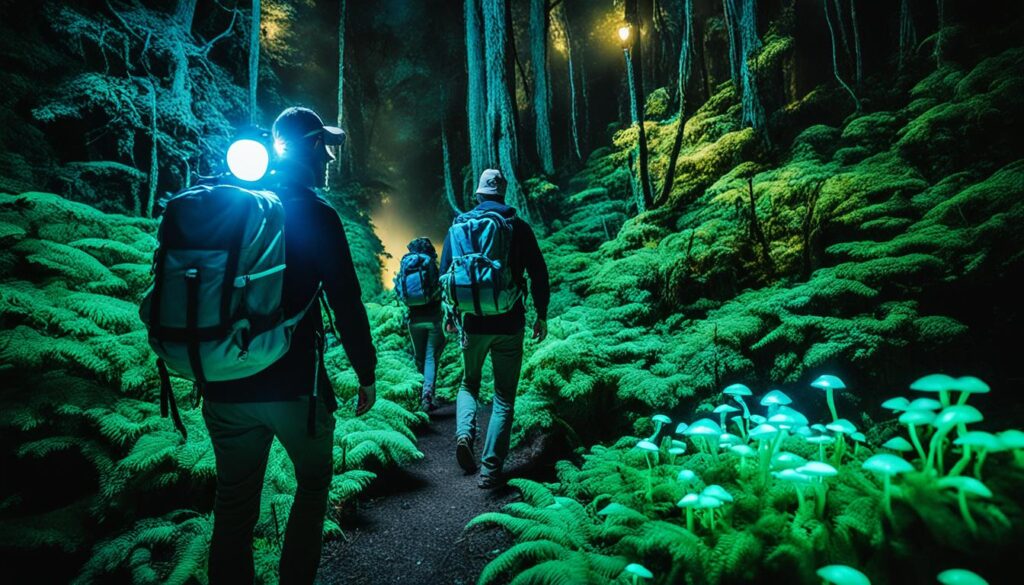
| Location | Highlights | Species Found |
|---|---|---|
| Atlantic Forest, Brazil | World’s highest concentration of glowing mushrooms | 27 species of bioluminescent fungi |
| Ribeira Valley | Guided nighttime tours | Includes well-known species like Omphalotus olearius |
| Amazon Rainforest | Discovery of Luminiscens amazonicus | New species with bluish-green glow |
Why Do Fungi Glow?
Glowing fungi have long caught the eye of both scientists and nature lovers. They mainly glow to draw insects, which help spread their spores. This light emission is key for their reproduction, allowing their spores to travel across the forest.
Attracting Insects and Spore Dispersal
Over 120 mushroom types glow using special substances to create their light. They can glow day and night, with some even timing their glow to stand out more at night. This smart timing saves energy and attracts night-time insects more effectively.
Research using model mushrooms with green lights proved they attracted more insects like beetles and flies. This shows the vital role these glowing fungi have in forests. With only 71 glowing types among over 100,000, these light-up mushrooms are rare and crucial for biodiversity.
The Neonothopanus gardneri mushroom is a prime example of glowing fungi’s role in nature. It’s among the brightest and uses its glow to attract insects at night. This showcases the deep connections within forests and how these fungi help maintain ecological balance.

Ecological Importance of Bioluminescent Fungi
Bioluminescent fungi are key in keeping biodiversity and improving the health of ecosystems. They glow and this glow plays a big part in the environment, especially in forests. By looking at these glowing fungi, we learn about how they live with other plants and animals. This shows how they help ecosystems work well.
Supporting Biodiversity
Bioluminescent fungi make forests full of life. They help spread spores and make sure different plants and fungi can grow. This is how they help keep a wide variety of life thriving. Their glow also shows how fungi are important in keeping the ecosystem healthy.
Potential Contributions to Ecosystem Functioning
These glowing fungi do more than just light up. They break down dead materials, helping to recycle nutrients. This keeps the soil healthy for plants to grow. Also, studies show they may build special connections with some microbes, improving how ecosystems function. Their uses in biotech, like in bioimaging and farming, are promising too.

| Aspect | Details |
|---|---|
| Species Diversity | Approximately 71 to 80 documented bioluminescent fungal species |
| Ecosystem Roles | Decomposers aiding in nutrient cycling and soil health |
| Metabolic Pathways | Unique light emissions through luciferin oxidation catalyzed by luciferase |
| Biogeographical Distribution | Found in old-growth and secondary forests, with varied substrates like fallen branches |
| Research Gap | Limited ecological studies, particularly in tropical regions |
Recent Discoveries in Bioluminescent Fungi
Recent discoveries in bioluminescence have shown us new paths in science and our understanding of fungi that glow. One fungus, Eoscyphella luciurceolata, shines a light on the progress in this field. It was featured in the Journal of Fungi, showing that more researchers are focusing on these glowing fungi.
Scientists have found important enzymes in plants that help fungi glow. This discovery is crucial, merging plant and fungal glow mechanisms could lead to big discoveries. It appears one plant gene can do the job of two fungal ones, making glowing simpler.
Using these fungal enzymes, companies like Light Bio have made plants that glow, such as Firefly Petunias and Chrysanthemums. These glow-in-the-dark plants help farmers watch over plant health and deal with stress, helping the environment.
Aside from enzymes and species, we now know more about glowing fungi. Out of 120,000 fungi known, only about 100 glow. This means there’s a lot more to find out there in different places.

New species being found, like Roridomyces in India, open doors for more research. This research could help save these glowing fungi’s homes, showing how important they are to nature and evolution.
Exploring the Atlantic Forest and Its Wonders
The Atlantic Forest is a window into one of the earth’s richest ecosystems, full of life and tradition. It is famous for having the most glowing mushrooms in the world. This habitat draws both scientists and nature lovers. In it, the mix of diverse life and preservation efforts makes experiences that last.
The World’s Highest Concentration of Glowing Mushrooms
In the Atlantic Forest, you can find amazing glowing fungi. There are tours that let you see these mushrooms up close. People can volunteer for various tasks, staying from weeks to months. This gives them a chance to admire the forest and help save it. Many say volunteering here was an incredible and unforgettable time.
Ecotourism and Conservation Efforts
This region shines in ecotourism, focusing on *sustainable tourism*. Projects like the Atlantic Forest Biodiversity Center grow up to 200,000 seedlings yearly. This helps keep the forest alive and well. It’s not just about mushrooms; there are unique species and many birds here too, making it very special.
“EdGE” and other projects bring volunteers from around the world. They learn about nature and help those living near the forest. There’s so much to do, from cave exploring and rafting to watching the stars. Tourism here is growing in a way that helps the forest and the people nearby. It makes sure the forest and its wonders last for everyone.
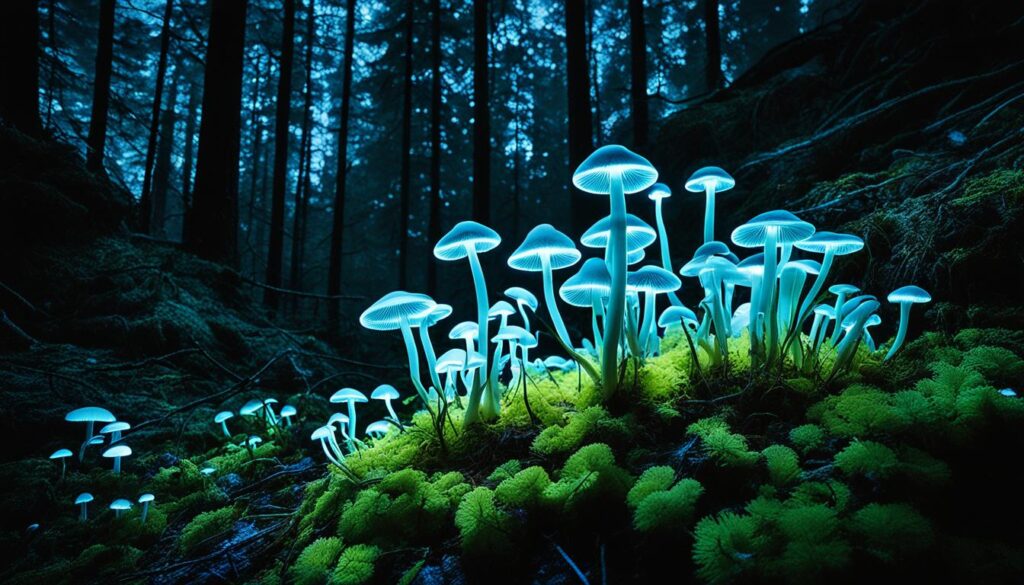
Conclusion
The magical world of bioluminescent fungi is a window into nature’s detailed beauty and its complexities. Only 71 out of more than 100,000 fungi species can glow. This rarity makes them uniquely fascinating. Their glow, which happens only at night, is controlled by an internal clock. This fact adds to the mystery and allure of these organisms.
This glowing ability helps bioluminescent fungi attract insects better than those that don’t glow. It shows us how these fungi play a part in their ecosystems. Research on making plants glow borrows from this natural wonder. It highlights why we must protect their natural habitats. Places like the Atlantic Forest and Amazon Rainforest are vital for preserving our planet’s biodiversity. They remind us of the importance of caring for these unique fungi.
Learning about and sharing knowledge on bioluminescent fungi is something everyone can do. By doing this, we help protect these amazing life forms. If we want future generations to see this natural glow, we need to act. Let’s work together to conserve the places these fungi call home. This way, the magical glow of bioluminescent fungi will continue to illuminate the natural world.


